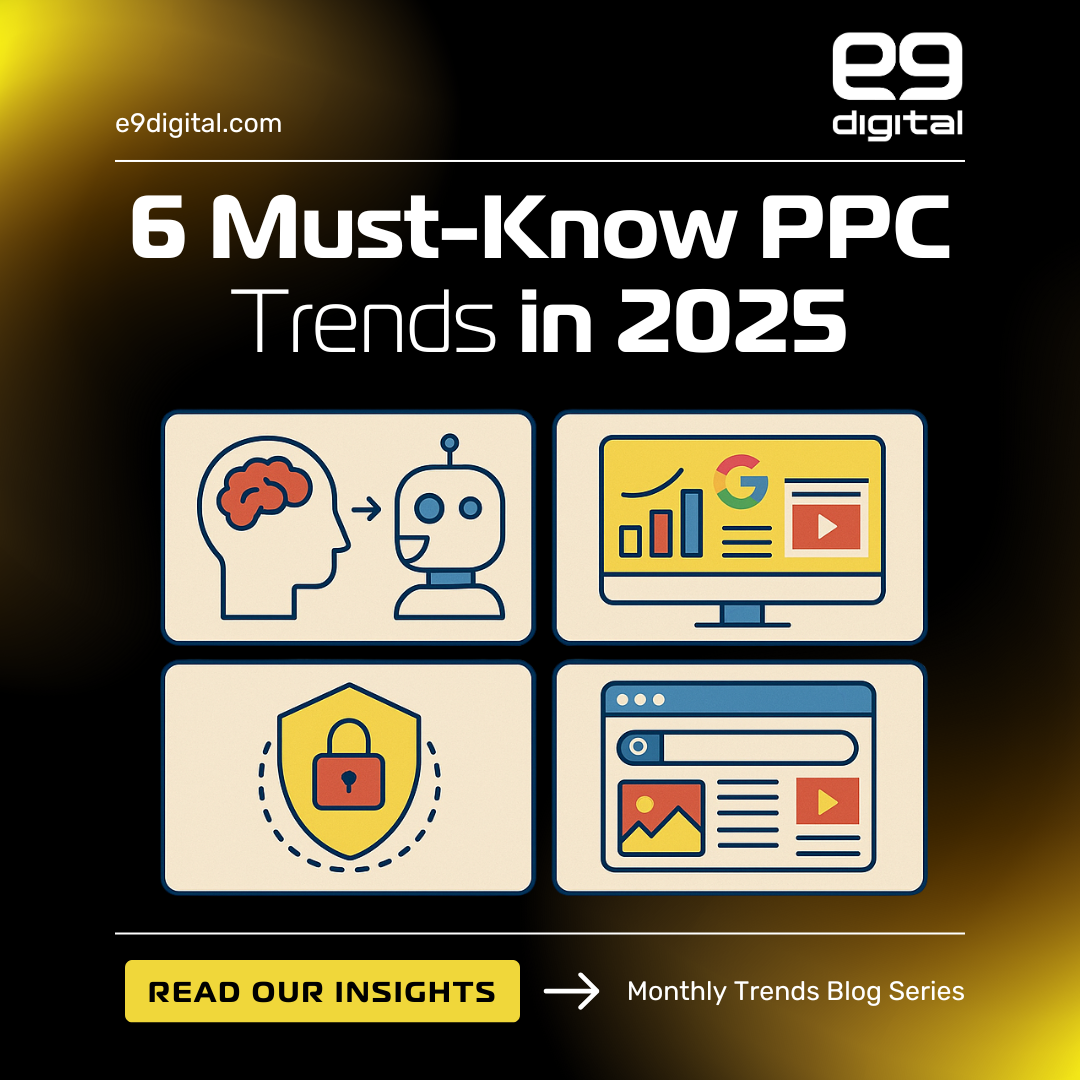Key Takeaways
- AI is reshaping PPC in 2025, but human strategy is still crucial to avoid costly missteps.
- Google Ads now relies on AI tools, first-party data, and scroll-stopping creative to drive results.
- Behavioral targeting is out; privacy-first, consent-based strategies are the new standard.
- Search results are becoming visual and interactive, requiring native-looking, creative ads.
- e9digital can lead your PPC strategy and turn clicks into real business growth.
If you’ve noticed your Google Ads account talking back to you, don’t panic—the robots have landed.
PPC (Pay-Per-Click) is the internet’s version of a toll booth: you pay every time someone clicks your ad. Whether popping up on Google Search, sliding into a Facebook feed, or sneaking into a YouTube video, PPC helps brands reach the right people at the right time. But in 2025, that “right time” is increasingly being predicted, executed, and optimized by artificial intelligence.
Welcome to the age of automated ad buying, AI-assembled creative, and machine learning-driven audience insights. But before you let a robot spend your entire budget on impulse buys and mysterious “performance-maximizing opportunities,” take a deep breath.
Humans still matter. (Especially the PPC experts at e9digital.)
Here’s what our in-house Director of Paid Media forecasts for 2025—and what you need to know to stay ahead of the game.

1. AI now powers your Google Ads account
Your Google Ads account is no longer just a tool; it’s a co-pilot. Buckle up.
Google is leaning heavily into AI-generated ad copy, dynamic visuals, and campaign optimization features that just work. In theory, you could upload your goals, sit back, and let the machines do their thing.
Here are the key AI shifts:
- Smart Bidding: Now tapping into richer intent signals and adapting in real-time.
- Performance Max (PMax): Google’s all-in-one AI-driven campaign type is no longer optional; it’s the default.
- Gemini AI in Ads: Generate headline variants, ad extensions, and even visuals based on user intent.
But here’s a big WARNING:
Letting the algorithm loose without human oversight is like giving your teenager a credit card and the keys to the car. Google aims to help you perform, but their business model is, well… to get you to spend.
So unless you know how to train the algorithm, set proper guardrails, and optimize results manually, you may find yourself funding Google’s lunch break. Work with an agency like e9digital to ensure your spending maximizes your results.
2. First-party data strategies are replacing cookies
Remember cookies? The internet’s favorite stalker is (finally) being phased out.
“As Chrome phases out third-party cookies, brands that have robust first-party data strategies will thrive.” - Stephanie Sprayregen, Director of Paid Media | e9digital
Here’s what first-party data strategies will look like in 2025:
| Customer Match:
Upload your customer email list to re-engage or upsell. |
CRM Integrations:
Sync your platforms so Google knows who your real VIPs are. |
Consent Mode 2.0:
Google’s upgraded consent framework helps you stay compliant while still collecting actionable data. |
Server-Side Tracking:
Moving tracking responsibility to your server makes it harder for browsers to block data. |
This isn’t just about data—it’s about user trust. Optimize for easy email capture, privacy transparency, and a smooth user experience.
3. Shifting from behavioral targeting to privacy-first targeting and measurement
As Google phases out behavioral targeting, advertisers face a new reality: fuzzy signals, modeled conversions, and AI-assembled audiences.
Here’s what’s changing in 2025:
- Privacy Sandbox & Topics API: Google’s answer to behavioral targeting without invading privacy.
- Modeled conversions: Machine learning fills in the gaps when tracking is blocked.
- Contextual targeting: Matching ads to content, not individual behavior.
- Consent-driven insights: Expect more campaigns to rely on what users allow—not what you can sneak past them.
In short, say goodbye to ultra-precise stalking (AKA retargeting) as we know it. Instead, businesses will have to use first-party data to create user groups with similar characteristics. It’s confusing, yes, but e9digital has you covered.
4. Creative ads are more important than keywords
In a shocking twist, 2025 has made creativity a performance metric. Google is pushing visual-forward ads across Search, Shopping, and Performance Max. Think scroll-stopping imagery, compelling video, and rich media that doesn’t feel like an ad.
The creative evolution involves:
- Dynamic ad formats that adjust to user behavior and placement.
- Visual assets are now essential, even in Search campaigns.
- Storytelling > selling: Campaigns that emphasize branding and narrative are winning over cold, keyword-stuffed ads.
“Google is pushing advertisers to utilize its dynamic formats that have more flexibility across all placement.” - Stephanie Sprayregen, Director of Paid Media | e9digital
Businesses need to switch to storytelling and brand-first creative in all channels. If your head’s swimming, don’t worry—e9digital has a full-fledged marketing team to help you craft your story through engaging content. We’ve been doing this for many different algorithms, including Google, Meta, and Bing.
5. Search results pages will look more like social feeds
Google’s Search Generative Experience (SGE) is an experimental version of Google Search that integrates generative AI to provide more comprehensive, conversational answers directly in the search results. It is transforming the search results page into something more visual, interactive, and—dare we say—TikTok-y?
Here’s what you can expect:
- Rich media answers appear before traditional ads or links.
- Branded vs. non-branded queries are blending together; users may not distinguish between a Google answer and your paid promotion.
- Visual storytelling matters more: If your ad doesn’t look like native content, it may never even get seen.
Your static headline + blue link formula just won’t cut it anymore. UX-friendly, creative formats are key.
“Users now see interactive, visual answers, sometimes before they ever reach paid results.” - Stephanie Sprayregen, Director of Paid Media | e9digital
6. Utilizing automation guardrails for improved ad results
2025 is not the year to fight automation—but it is the year to manage it smarter. Practice automation layering, a strategy that blends AI tools and manual optimizations for improved ad results. Here’s how to automate without surrendering control:
- Automation layering: Combine Google’s AI with human-built strategy layers (like audience exclusions or manual placements).
- Budget pacing tools: Ensure your budget doesn’t vanish on Day 2 of the month.
- Bid strategy testing: Regularly test strategies (Target CPA vs. Max Conversions) to keep the algo honest.
- Strategic oversight: Set performance thresholds, review placements, and adjust based on actual business outcomes.
- Adopt a test and learn philosophy: Use past data to inform business decisions.
The proof is in the pudding: $1 million in retained case value
What could you do if your law firm made an estimated $1 million in retained case value in 9 months? Well, that’s what e9digital’s PPC strategy delivered for one of our law firm clients.
With our highly specific methods, we successfully achieved:
- Monthly click-through rates of up to 16% (the average for the legal sector is 2.93%!)
- Search impression shares of up to 98%, keeping our client top of mind for their target audience.
Let e9digital steer your PPC ship
PPC is shaping up to be less about manual optimization and more about orchestration, mixing AI, creative, data strategy, and good old-fashioned marketing brains. However, you need an expert to maximize lead generation and ad success. Our PPC team at e9digital understands emerging trends and can direct the robots the right way to ensure a winning ad campaign.
Stop worrying about getting the most bang for your buck with your PPC campaign. Contact e9digital to learn more—we speak fluent human and robot.
PPC Glossary
Performance Max
A goal-based Google Ads campaign type that uses machine learning to serve ads across all Google inventory (Search, Display, YouTube, Discover, Gmail, and Maps) from a single campaign, optimizing for performance in real time.
Smart Bidding
A subset of automated bid strategies in Google Ads that uses machine learning to optimize for conversions or conversion value in auctions based on real-time signals like device, location, time of day, and more.
Gemini AI
Google’s family of next-generation generative AI models developed by DeepMind, integrated into various Google products, including ads and the Search Generative Experience, to enhance understanding, summarization, and creative outputs.
Consent Mode 2.0
An updated version of Google’s Consent Mode that allows websites to adjust the behavior of Google tags based on users’ consent choices and supports more privacy-conscious tracking for ad personalization and measurement in the EU under the Digital Markets Act.
Server-side tracking
A method of tracking user interactions by sending data from a website’s server to platforms like Google Analytics or Meta, instead of relying solely on client-side (browser) cookies, enhancing data control, accuracy, and privacy compliance.
Behavioral targeting
An advertising technique that uses a user’s past online behavior, such as pages visited, search queries, or purchases, to serve more relevant ads based on predicted interests.
Privacy Sandbox
Google’s initiative to develop privacy-preserving alternatives to third-party cookies by introducing new web standards and APIs that support advertising needs (like targeting and measurement) while reducing user tracking.
Topics API
Part of the Privacy Sandbox, this API replaces third-party cookies by categorizing users into interest-based topics (e.g., “Fitness” or “Travel”) based on their recent browsing, which advertisers can use to serve relevant ads without detailed tracking.
Modeled conversions
Estimated conversions that Google Ads or Analytics attributes to ad interactions when direct tracking is unavailable, often due to privacy restrictions or cookie consent, generated using statistical modeling techniques.
Contextual targeting
A strategy where ads are shown based on the content of a web page (e.g., showing a sports equipment ad on a fitness blog) without relying on user behavior or personal data.
Google’s Search Generative Experience (SGE)
An experimental version of Google Search that uses generative AI to create dynamic summaries and answer user queries with synthesized insights from multiple sources, often including follow-up suggestions and links to web content.
Automation Layering
A PPC strategy that involves combining Google’s automation tools (like Smart Bidding) with manual optimizations or third-party scripts to maintain control while benefiting from machine learning.
Budget Pacing Tools
Features or third-party tools used to control and distribute ad spend evenly over time, helping advertisers avoid overspending early in a campaign cycle and ensuring budget alignment with performance goals.
Bid Strategy Testing
The practice of comparing different automated or manual bidding strategies (e.g., Target CPA vs. Maximize Conversions) in a controlled experiment to determine which yields better results for a campaign’s goals.
